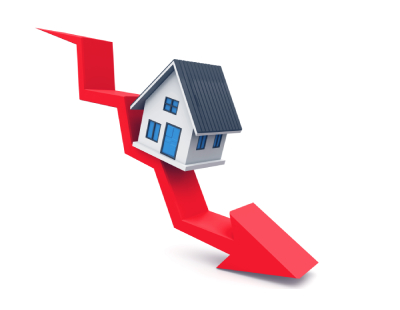
The pandemic-inspired property demand boom is well and truly over, GetAgent claims.
It comes as the agent comparison website’s latest Hotspot Demand Index found home hunter levels declined by 9.2% during the fourth quarter of 2022.
The analysis monitors homebuyer demand across England on a quarterly basis.
Current demand is based on the proportion of stock listed as sold subject to contract or under offer as a percentage of all stock listed for sale on Rightmove.
The latest index shows that across England, buyer demand is currently at 48.3% which marks a 9.2% decline since the third quarter of 2022 and 17.3% drop since this time last year.
The website said this suggests the pandemic-inspired property boom is being brought well and truly back down to earth by the significant economic pressures facing the nation’s would-be homebuyers.
England’s strongest sales demand hotspot is currently in Durham where it sits at 68%. This is still 5.6% lower than the third quarter of 2022 and 14.5% down annually.
No parts of England have experienced sales demand growth in the past year or the previous quarter.
Colby Short, chief executive of GetAgent, said: “After a couple of years of manic demand, activity, and price increases, we end 2022 with a gentle bump back down to earth. Economic gravity was always destined to enforce the declines we’re currently seeing and, in many ways, it’s a surprise that it's taken this long to happen.
“You’re going to read all sorts of pessimistic property headlines over the coming months, but the forecast isn’t actually that bleak. Look at the long-term history of house prices and you’ll see that the property market is never down for long, regardless of how many pandemics and economic crashes are thrown its way.
“However, the fortunes of the housing market are very much in the hands of the Bank of England at the moment because, until interest rates come down and borrowing becomes more affordable, lenders are going to be tighter with their mortgage offers and buyers are going to be nervous about taking on these relatively high levels of risk.”
| Table shows home sales demand in English regions for Q4 2022, alongside the annual and quarterly % change |
| |
|
Location |
Q4 2022 Demand % |
Q change |
Annual change |
| |
|
Durham |
68.0% |
-5.6% |
-14.6% |
| |
|
City of Bristol |
56.6% |
-7.8% |
-17.2% |
| |
|
Surrey |
56.4% |
-9.0% |
-17.0% |
| |
|
Greater London |
55.9% |
-7.9% |
-19.3% |
| |
|
City of London |
54.8% |
-9.3% |
-20.3% |
| |
|
Devon |
54.2% |
-9.4% |
-19.3% |
| |
|
Bath and North East Somerset |
54.1% |
-8.7% |
-19.3% |
| |
|
Oxfordshire |
53.7% |
-10.7% |
-21.5% |
| |
|
Wiltshire |
53.5% |
-5.9% |
-12.9% |
| |
|
Hertfordshire |
53.5% |
-9.3% |
-17.0% |
| |
|
Cornwall |
53.2% |
-8.5% |
-22.0% |
| |
|
Dorset |
52.9% |
-9.3% |
-21.6% |
| |
|
Essex |
52.7% |
-8.6% |
-19.1% |
| |
|
Suffolk |
52.1% |
-3.6% |
-9.8% |
| |
|
Berkshire |
51.6% |
-7.6% |
-22.5% |
| |
|
Hampshire |
51.4% |
-9.6% |
-21.9% |
| |
|
South Yorkshire |
51.4% |
-9.4% |
-13.0% |
| |
|
Gloucestershire |
51.1% |
-10.1% |
-17.4% |
| |
|
Somerset |
50.9% |
-8.1% |
-15.7% |
| |
|
Tyne and Wear |
50.9% |
-9.8% |
-17.7% |
| |
|
Merseyside |
50.8% |
-8.9% |
-12.9% |
| |
|
West Sussex |
50.3% |
-9.9% |
-17.7% |
| |
|
Herefordshire |
50.2% |
-10.9% |
-17.0% |
| |
|
Lancashire |
50.1% |
-10.4% |
-18.1% |
| |
|
Worcestershire |
49.8% |
-10.0% |
-22.3% |
| |
|
Kent |
49.7% |
-11.0% |
-22.2% |
| |
|
West Midlands (county) |
49.7% |
-11.5% |
-20.0% |
| |
|
Cumbria |
49.6% |
-10.1% |
-18.4% |
| |
|
Cambridgeshire |
49.5% |
-10.4% |
-18.3% |
| |
|
East Sussex |
49.4% |
-11.1% |
-19.8% |
| |
|
Cheshire |
49.0% |
-10.3% |
-17.4% |
| |
|
Greater Manchester |
48.8% |
-11.1% |
-20.5% |
| |
|
North Yorkshire |
48.8% |
-11.2% |
-20.6% |
| |
|
Buckinghamshire |
47.7% |
-10.2% |
-19.4% |
| |
|
West Yorkshire |
47.2% |
-9.7% |
-20.9% |
| |
|
Rutland |
47.1% |
-7.9% |
-13.2% |
| |
|
Northamptonshire |
46.5% |
-10.9% |
-21.1% |
| |
|
Northumberland |
46.0% |
-10.8% |
-15.4% |
| |
|
Shropshire |
45.6% |
-9.4% |
-18.4% |
| |
|
Warwickshire |
44.9% |
-9.8% |
-16.8% |
| |
|
Norfolk |
44.9% |
-9.5% |
-18.4% |
| |
|
Derbyshire |
44.5% |
-8.5% |
-24.8% |
| |
|
Nottinghamshire |
44.2% |
-9.5% |
-22.2% |
| |
|
Staffordshire |
43.6% |
-12.7% |
-23.0% |
| |
|
Bedfordshire |
42.3% |
-12.8% |
-22.7% |
| |
|
Isle of Wight |
41.8% |
-12.1% |
-25.5% |
| |
|
Leicestershire |
39.1% |
-6.2% |
-8.0% |
| |
|
East Riding of Yorkshire |
37.8% |
-12.9% |
-25.5% |
| |
|
Lincolnshire |
18.8% |
-7.4% |
-4.7% |
| |
|
England |
48.3% |
-9.2% |
-17.3% |
















.png)


.png)




Join the conversation
Be the first to comment (please use the comment box below)
Please login to comment